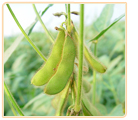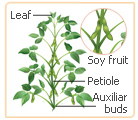What is Soy?
 Soy is a derivative of the soybean. Soybeans are legumes that differ slightly from other legumes (beans, peas and lentils) as they are low in carbohydrates but high in fiber. Like other legumes, they are also high in fiber however soybeans supply all the amino acids needed to maintain a healthy diet. Soy is a derivative of the soybean. Soybeans are legumes that differ slightly from other legumes (beans, peas and lentils) as they are low in carbohydrates but high in fiber. Like other legumes, they are also high in fiber however soybeans supply all the amino acids needed to maintain a healthy diet.
Fascinatingly, the amino-acid pattern of soy protein is akin to that found in meat, milk, and egg protein. Soybean is the food of "balance" as it is the only vegetable food that contains complete protein.
Background and History of Soy
 Millions of people in the Orient have been using soybeans and soybean products as a source of protein and medicine for centuries. The history of soybean use as food in the Western World didn't develop until the 20th century when the demand increased as markets developed for oil and soybean meal used in animal feeds as a protein source. Millions of people in the Orient have been using soybeans and soybean products as a source of protein and medicine for centuries. The history of soybean use as food in the Western World didn't develop until the 20th century when the demand increased as markets developed for oil and soybean meal used in animal feeds as a protein source.
Since the 1950�s human consumption of soy protein products has grown significantly. In the 1970's, the Western world adopted the vegetarian diet both as a form of protest and as a way to eat healthier. Soy protein was their substitute for meat. As studies show the potential of soy to reduce the risk of disease, the consumption of soy based food continues to grow. In the US alone, approximately more than one billion pounds of protein products for human consumption is produced annually.
Continue reading below to learn more about soy.
Chemical Composition of Soy
 Soybeans contain phytoestrogens and isoflavones, both of which can lower cholesterol and prevent disease. Such substances can reduce the risk of heart disease, certain forms of cancer, and osteoporosis. It can also maintain diabetes and ease menopausal symptoms. Soy products, including tofu, soy milk, soy flour and soy nuts have higher isoflavone concentrations than foods that combine soy and grains. Currently, soy isoflavones are being studied to clarify their physiological effects. Existing research shows that isoflavones may be the cause of soybeans disease fighting potential. Soybeans contain phytoestrogens and isoflavones, both of which can lower cholesterol and prevent disease. Such substances can reduce the risk of heart disease, certain forms of cancer, and osteoporosis. It can also maintain diabetes and ease menopausal symptoms. Soy products, including tofu, soy milk, soy flour and soy nuts have higher isoflavone concentrations than foods that combine soy and grains. Currently, soy isoflavones are being studied to clarify their physiological effects. Existing research shows that isoflavones may be the cause of soybeans disease fighting potential.
Now that the chemical composition of soy has been explained, continue reading below to learn how soy grows.
How Does Soy Grow?
For thousands of years, Soy was initially a legume ground cover that Chinese farmers pushed aside. Grown this way, as a legume, soy drew nitrogen from the air and through it roots it deposited it and enriched the soil. This was how it was grown up until about three thousand years ago when the Chinese farmers discovered the plant could grow upright. As most of China's land is marginal, or in strips, this new way of growing soon made soy a prized crop in the limited growing areas of China.
Soy plants can grow up to three feet high and three feet wide and bear 60 - 80 seedpods if three beans each. Soy plants enrich soil as well.
Continue reading below to learn what soy looks like.
What does Soy Look Like?
 The soy bean plant is made up of green leaves. As the plant matures it grows a green pod enveloping the beans, similar to the way a pea pod looks. The actual color of the soybean changes with time. Young soybeans are green. They taste sweeter and are used to make edamame. As the soybean matures it changes to beige or brown and is used to make tofu or soy milk etc. This is why soymilk is beige-colored and not green. The soy bean plant is made up of green leaves. As the plant matures it grows a green pod enveloping the beans, similar to the way a pea pod looks. The actual color of the soybean changes with time. Young soybeans are green. They taste sweeter and are used to make edamame. As the soybean matures it changes to beige or brown and is used to make tofu or soy milk etc. This is why soymilk is beige-colored and not green.
Now that it�s been explained what soy is and its origins as a herb for menopause, click on the following link to learn about how soy works.
Which herb should women try? Today women are looking for relief from their menopause symptoms with herbs. Phytoestrogenic herbs and non-estrogenic herbs are good in relieving menopause symptoms, but recent studies show that non-estrogenic herbs have no side effects because they help the body to produce its own hormones instead of introducing hormones like the phytoestrogenic ones. Learn more about non-estrogenic herbs for menopause.
| 

